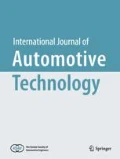Abstract
This research concerns the design of a powertrain system for a plug-in parallel diesel hybrid electric bus equipped with a continuously variable transmission (CVT) and presents a new design paradigm for the plug-in hybrid electric bus (HEB). The criteria and method for selecting and sizing powertrain components equipped in the plug-in HEB are presented. The plug-in HEB is designed to overcome the vulnerable limitations of driving range and performance of a purely electric vehicle (EV), and it is also designed to improve the fuel economy and exhaust emissions of conventional buses and conventional HEBs. Optimization of the control strategy for the complicated and interconnected propulsion system in the plug-in parallel HEB is one of the most significant factors for achieving higher fuel economy and lower exhaust emissions in the hybrid electric vehicle (HEV). In this research, the proposed control strategy was simulated to prove its validity using the ADVISOR (advanced vehicle simulator) analysis simulation tool.
Similar content being viewed by others
References
Anderson, C. D. and Anderson, J. (2005). Electric and Hybrid Cars: A History.
Burke, A. F. (1993). On-Off Engine Operation for Hybrid/ Electric Vehicle: Electric and Hybrid Vehicle Advancements. SAE Publication SP-969. Warrendale.
Chan, C. C. and Chau, K. T. (2001). Modern Electric Vehicle Technology. Oxford University Press. Oxford.
He, B., Ouyang, M. and Lu, L. (2006). Modeling and PI control of diesel APU for series hybrid electric vehicles. Int. J. Automotive Technology 7,1, 91–99.
Markel, T. and Wipke, K. (2001). Modeling grid-connected hybrid electric vehicles using ADVISOR. NREL/CP-540-30601.
Matheson, P. (2003). Modeling and simulation of a fuzzy logic controller for a hydraulic-hybrid powertrain for use in heavy commercial vehicles. SAE Paper No. 2003-01-3275.
Trigui, R., Badin, F., Jeannert, B., Harel, F., Coquery, R., Lallemand, R., Ousten, J. P., Castagne, M., Debest, M., Gittard, E., Vangreefshepe, F., Morel, V., Baghli, L., Reaaoug, A., Labbe, A., Labbe, J. and Biscaglia, S. (2003). Hybrid light duty vehicles evaluation program. Int. J. Automotive Technology 4,2, 65–75.
Wang, B. H., Zhang, J. W. and Luo, Y. G. (2007). The rapid development of parallel hybrid propulsion control system by an online calibrating system. J. Automobile Engineering, 221, 1555–1565.
Wang, W., Zeng, X. and Wang, Q. (2003). Develop hybrid transit buses for chinese cities. SAE Paper No. 2003-01-0087.
Wipke, K. B., Cuddy, M. R. and Burch, S. D. (1999). ADVISOR 2.1: A user-friendly advanced powertrain simulation using a combined backward/forward approach. NREL/JA-540-26839.
Zeng, X., Zeng, X., Qingnian, W., Weihua, W. and Liang, C. (2005). Analysis and simulation of conventional transit bus energy loss and hybrid transit bus energy saving. SAE Paper No. 2005-01-1173.
Zhou, R. S. and Hashimoto, F. (2004). Highly compact electric drive for automotive applications. SAE Paper No. 2004-01-3037.
Author information
Authors and Affiliations
Corresponding author
Rights and permissions
About this article
Cite this article
Suh, B., Frank, A., Chung, Y.J. et al. Powertrain system optimization for a heavy-duty hybrid electric bus. Int.J Automot. Technol. 12, 131–139 (2011). https://doi.org/10.1007/s12239-011-0017-9
Received:
Revised:
Published:
Issue Date:
DOI: https://doi.org/10.1007/s12239-011-0017-9




